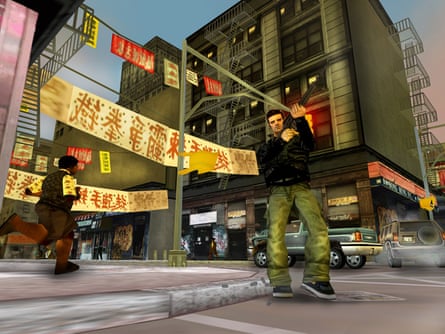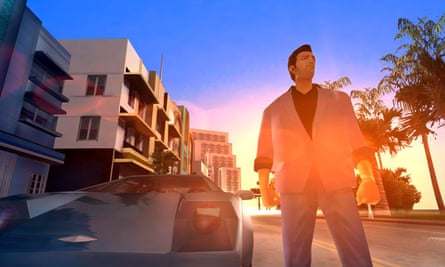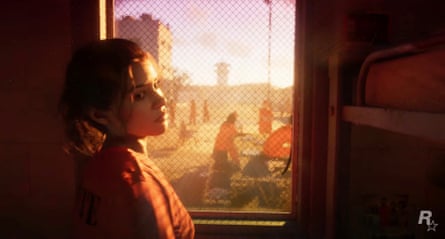GTA is a series of crime-drama video games set in fictionalised cities (mostly) around the US. In each game, the player takes on the role of a criminal (or criminals) navigating the violent underworld of modern America, stealing cars and carrying out missions and heists for a range of shadowy kingpins. The later games in particular are home to vast, freely explorable cities or states and, outside of missions, players are free to do whatever they want, whether that’s exploring the countryside on a bike or taking on side jobs for car thieves, drug smugglers or corrupt politicians.
The original Grand Theft Auto was designed by a Dundee-based studio, DMA Design, which also produced the famed platforming series Lemmings. At the time, the game was an unloved project and publisher BMG Interactive almost canned it several times. Now it is one of the most successful franchises in existance, created by developer Rockstar’s studios across the world, and led from Edinburgh by Rockstar North.
Grand Theft Auto (1997)
In this first instalment, players choose a character from eight possible options, then run around three crudely drawn cities viewed from a top-down perspective – Liberty (based on New York), San Andreas (San Francisco) and Vice City (Miami) – stealing cars, running over pedestrians and completing jobs for a powerful hoodlum. Released on the PlayStation and PC, it quickly attracted media outrage for its amoral violence. BMG Interactive hired publicist Max Clifford, who decided to stoke the controversy, resulting in then Scottish secretary Lord Campbell of Croy condemning the game in the House of Lords. Two expansion packs, GTA London 1969 and London 1961, followed – they are so far the only GTA games that take place outside the US.
Grand Theft Auto 2 (1999)

Set in the futuristic Anywhere City, the sequel looks almost identical to its predecessor, with the same top-down visuals, anonymous lead character and open-world, mission-based gameplay. However, it adds the concept of competing crime syndicates, which the player can work for, gaining respect and unlocking better tasks. It also allows you to take on legal side jobs such as taxi driving and parcel delivery. It is largely forgettable, apart from the fact it came with an eight-minute live-action movie intro, and was the only GTA game to appear on Sega’s Dreamcast console.
Grand Theft Auto III (2001)

Designed by new studio Rockstar North following the closure of DMA Design, this game marked the beginning of the modern GTA era. The concept of carrying out illegal jobs for criminal gangs remained, but now the lead character had a backstory: he was seeking revenge, having been double-crossed after a heist. Vitally, it was also the first game in the series to use a fully 3D environment: an overhauled take on the NYC-themed Liberty City. This move away from the top-down view, together with the vibrancy of its game world, the interesting low-life characters and star voice acting performances from Debi Mazar and Kyle Maclachlan, made for a critical and commercial smash hit. Once again controversy followed when it was discovered that players could pick up sex workers for a health boost then kill them to get their money back – though, contrary to the outraged reporting of the time, the game never mandated such behaviour. GTA’s philosophy is that players should be able to do what they want, even if that thing is toe-curlingly amoral.
Later, two handheld titles would serve as prequels to the game: 2004 saw the release of Grand Theft Auto Advance on the Game Boy Advance, which owed much to the first two GTA titles in its visual style. The following year, Rockstar Leeds released Grand Theft Auto: Liberty City Stories on the Sony PSP, which brought 3D visuals to the handheld spin-offs.
Grand Theft Auto: Vice City (2002)

Now we get to what some consider the defining game in the series: the tale of gangster-on-the-make Tommy Viccenti, freshly released from prison and looking to rise up the criminal ranks of Vice City, a sleazy metropolis based on Miami. Yes, it’s basically Brian de Palma’s Scarface mixed with Miami Vice, boasting a similar blend of cool music, hot drugs and rampant violence. The 80s setting, with its accompanying soundtrack of contemporary pop, was a brilliant idea, allowing players to blow up speedboats and crash aeroplanes while listening to Flock of Seagulls. This was also when the controversy really hotted up. The Haitian Centers Council criticised the game’s depiction of immigrants, and Rockstar became the subject of two multimillion-dollar lawsuits brought by the families of murder victims in cases in which the game was alleged to have influenced the killers.
A prequel adventure, called Grand Theft Auto: Vice City Stories, arrived on the Sony PSP handheld in 2006, featuring a cameo voice acting performance by Phil Collins.
Grand Theft Auto: San Andreas (2004)

Set in Rockstar’s version of California, including its LA-like city Los Santos, this is very much the developer’s take on Boyz n the Hood, Menace II Society and the many other similar movies from the late 1990s. Carl “CJ” Johnson is an ex-gang member who returns to the hood for his mother’s funeral and slips back into his old ways. The vast map encompasses three cities and varied landscapes, and a wealth of activities from gambling to cycling. It also has one of the best villains in the series: Officer Frank Tenpenny, voiced by Samuel L Jackson.
GTA: San Andreas will also be remembered for the “Hot Coffee” scandal, in which a sex scene originally edited out of the game was found by hackers, still lurking in the code, and made available online. Congress demanded action and Rockstar founders Sam and Dan Houser found themselves in the middle of their own nerve-wracking side quest: being interrogated by the Federal Trade Commission.
Grand Theft Auto IV (2008)

Rockstar’s dark fable about the immigrant experience follows eastern European former soldier Niko Bellic, who arrives in Liberty City to pursue the American dream – which in his case means organised crime. It was the first GTA to feature the cellphone as a HUD device, allowing Niko to order taxis, call friends and manage his growing riches. The game is famous for its more gritty tone – and for the neediness of Niko’s cousin Roman, who always, always wants to go bowling. The game didn’t cause as many specific controversies as earlier ones had, although Mothers Against Drunk Driving (MADD) tried to get it reclassified as adults-only in the US due to its depiction of car chases with intoxicated drivers.
The game spawned two follow-up chapters in 2009, The Lost and Damned and The Ballad of Gay Tony, a sign of Rockstar’s growing interest in extending the lifespan of each major GTA release.
Grand Theft Auto V / GTA Online (2013)

Originally released on the Xbox 360 and PlayStation 3, GTA V would become a behemoth. Where GTA 4 was a takedown of the American dream, this game took aim at every corrupt and hypocritical aspect of modern America. The game returned us to San Andreas, Rockstar’s fictional California, and the city of Los Santos, this time in the company of three protagonists: reluctantly retired middle-aged gangster Michael, hustler Franklin, and hillbilly psycho Trevor. Cleverly, these three characters compartmentalised three aspects of Grand Theft Auto’s personality – satirical cinematic ambition, character-led crime drama, and violent mayhem – giving Rockstar an outlet for every kind of GTA mission from trying to assassinate toxic social-media moguls to car chases across the desert.
It had the biggest game world we had yet seen anywhere, rendered in detail from the peaks of the mountains down to Michael’s local tennis courts. And that world would become home to tens of millions of players throughout the next decade thanks to GTA Online, the multiplayer mode that Rockstar launched shortly after GTA V’s release. Though its early months were a mess – you could tell the developer had never run an online game before, and the servers struggled to cope with demand in the first weeks, randomly deleting players’ characters and progress – it has since grown into one of the most profitable online games ever made. It took them years to get there, but Rockstar eventually realised the dream of rampaging in San Andreas with friends, planning heists and accumulating supercars.
Grand Theft Auto 6 (2025)

Bringing Grand Theft Auto V to new consoles, and keeping GTA Online continually updated with new mayhem for players to get up to, evidently kept Rockstar busy, and there will likely be an unprecedented 12-year gap between games. Grand Theft Auto 6 was finally shown off for the first time in a brief trailer in December 2023, around the time of Rockstar Games’ 25th anniversary. It will be set back in Vice City and the surrounding, distinctly Floridian state of Leonida, and will feature two partner-in-crime protagonists – one of whom is the series’ first female progatonist, an ex-con called Lucia. Whether that will be enough to address long-running criticisms of Grand Theft Auto’s treatment of women remains to be seen.
The real America has changed so much since GTA V that it’s difficult to see what satirical grenades Rockstar will be able to deploy. In a world in which Donald Trump was president for four years, and that still wasn’t enough to put people off voting for him again, what more absurd fictional scenario could a game concoct?

